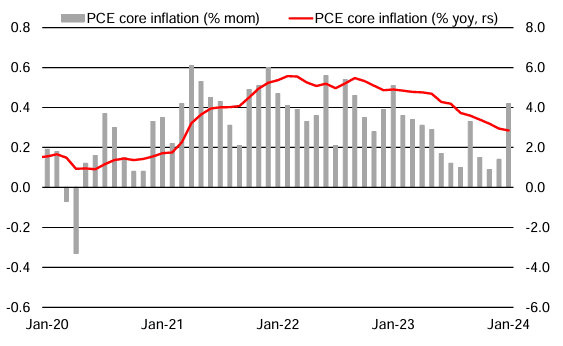Euro to Dollar Week Ahead Forecast: Threatening a Break Below 1.08
- Written by: Gary Howes
-

Image © Adobe Images
The Euro to Dollar exchange rate risks further losses this week as the technical setup breaks down, and it will only be on Friday when a potential market-shifting U.S. PCE inflation figure is released.
The Euro-Dollar fell sharply last week on account of growing expectations that the European Central Bank would cut interest rates as soon as June, while at the same markets saw growing odds that the Federal Reserve might only be in a position to cut rates in July.
This divergence in expectations favours ongoing U.S. Dollar strength into month-end. Analyst Shaun Osborne at Scotiabank says Euro-Dollar's short-term technicals are "bearish... losses from near the top of the EUR’s recent trading range have dumped spot back to near the low end of the recent trading range".
He says intraday price patterns are showing some signs of moderation in the EUR sell-off, "but its marginal at this point and a closer examination of the 1.08 area may yet develop".
He notes solid support at this level helped lift the EUR tone when tested in late February.
Above: EUR/USD at daily intervals with horizontal support and the 200DMA illustrated. Track EUR/USD with your own custom rate alerts. Set Up Here
The pair now trades below the 50-, 100- and 200-day moving averages, which is a clear signal that the trend is flipping from positive to bearish. The ADX has fallen to 37 and is pointed lower, confirming a turn in momentum to the downside is potentially underway.
"We have that pair down through the moving averages and into the 1.0815 zone. A move through 1.0800 would open a test of 1.0700 which is around the lows of the year," says W. Brad Bechtel, Global Head of FX at Jefferies LLC.
Live EUR/USD Money Transfer Exchange Rate Checker | ||
Live Market Rate: | get quick quote | |
Corpay: | ||
Banks: Median Low | ||
Banks: Median High | ||
These data are based on the spread surveyed in a recent survey conducted for Pound Sterling Live by The Money Cloud. | ||
Turning to the risk calendar for the Eurozone, Spain will release inflation figures on Wednesday.
Spanish inflation tends to lead that of the Eurozone due to fast pass-through effects and could offer a clue as to whether the disinflation trend across the broader Eurozone is still intact.
"We continue to think that the GBP would do relatively better vs the EUR that could remain vulnerable to any potential downside inflation surprises in coming days," says Valentin Marinov, Head of FX Research at Crédit Agricole.
The Eurozone-wide inflation figures would also be released this week were it not for the Easter holidays and they will be released early the following week.
"The inflation data in particular will be closely scrutinised by FX investors as it could be instrumental for the outcome of the 11 April ECB policy meeting. In that, any downside surprises could corroborate the market expectation that the Governing Council would start preparing the ground for a potential rate cut as soon as the June policy meeting. In turn, the build-up of market ECB rate cut expectations could intensify and once again worsen the EUR’s rate disadvantage," says Marinov.
Looking at the U.S. schedule, we have an important inflation release due for release Friday.
Above: U.S. PCE inflation, image courtesy of UniCredit.
The Federal Reserve watches the Personal Consumption Expenditures (PCE) index for an insight into inflationary pressures facing U.S. consumers. The data is due Friday (note most markets will be closed owing to the Easter holidays), and the headline rate is anticipated at 0.4 month-on-month in February.
A beat of this figure would further expectations that the Fed has no need to cut interest rates, which would underpin the Dollar's recent rally.
"Continuing evidence that the U.S. economy is still largely resilient and the labour market remains tight as well as indications that the Fed is less unanimous on the need for aggressive easing in the face of an improving economy, could help the USD recover in the near term," says Valentin Marinov, Head of FX Research at Crédit Agricole.





